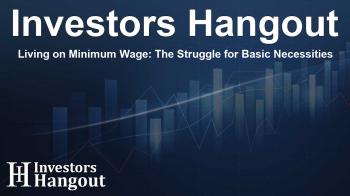Living on Minimum Wage: The Struggle for Basic Necessities

The Financial Burden of Living on Minimum Wage
In 2024, living on minimum wage has become an overwhelming challenge. New statistics reveal that rent now consumes a staggering 90% of a minimum wage worker's paycheck. This percentage is alarming, particularly when you consider the additional expenses for food, utilities, and transportation that workers must cover.
Examining the Impact of Minimum Wage Stagnation
The federal minimum wage stands at $7.25 per hour, unchanged since 2009. This translates into approximately $1,276 earned monthly by a full-time worker. With the average rent in the U.S. now at $1,148 per month, only $128 is left for other living expenses. This leaves individuals in a precarious financial situation, unable to afford basic necessities.
The Rising Costs of Living Are Unmanageable
To illuminate the reality, let's look back at 1984 when minimum wage workers allocated only 41% of their earnings to rent. Fast forward to today, and this percentage has skyrocketed. In addition, average utility costs have surged to 32.8% of minimum wage income, while food expenses account for another 67.4%. As a result, the financial math simply doesn't add up for these workers.
Homeownership: An Inaccessible Dream
For those envisioning the dream of owning a home, the situation is grim. Currently, the average home price is a staggering 23.4 times the annual earnings of a full-time minimum wage salary. This is a significant increase from 13.8 times in 1984. Furthermore, payments for even the most affordable homes now demand an outrageous percentage of a minimum wage worker's earnings.
The Reality for Couples on Minimum Wage
The notion that two minimum wage earners can easily combine their finances to afford living costs is misleading. While two full-time workers might bring home approximately $2,552 monthly, rent still takes a considerable chunk out of this income. When factoring in other essential costs such as food and healthcare, couples still find themselves financially stressed. The stark difference in living costs over the years is evident, with basic expenses now consuming 164.4% of income for homeowners and even higher for renters.
Navigating a Financially Stretched Future
Today's minimum wage never intended to create wealth, but in 2024, it's failing to provide enough for mere survival. Rent and essential life costs are increasingly threatening the livelihood of workers. Without significant changes in wage policies or living costs, those earning minimum wage continue to encounter an uphill battle to meet their needs and secure a stable future.
Exploring Investment Opportunities for Future Comfort
For individuals seeking ways to secure financial stability, exploring higher-yield investment opportunities may provide some relief. A shifting market is paving the way for income-focused investments that can offer substantial returns. From private real estate markets to innovative financial vehicles, new avenues exist for savvy investors aiming to build wealth strategically.
Frequently Asked Questions
What percentage of a minimum wage salary goes to rent?
Currently, rent takes up around 90% of a full-time minimum wage earner's paycheck.
How has the federal minimum wage changed over the years?
The federal minimum wage has remained at $7.25 per hour since 2009, with no adjustments for inflation or cost of living increases.
Is homeownership realistic for minimum wage earners?
Homeownership is increasingly unattainable, with average home prices now 23.4 times the salary of a full-time minimum wage worker.
What are the current living costs in relation to minimum wage income?
Current living costs exceed income, with expenses such as rent, utilities, and food consuming more than the earnings of minimum wage workers.
What alternatives exist for those struggling financially?
Seeking higher-yield investment opportunities or considering alternative income streams can help improve financial security for minimum wage earners.
About The Author
Contact Dylan Bailey privately here. Or send an email with ATTN: Dylan Bailey as the subject to contact@investorshangout.com.
About Investors Hangout
Investors Hangout is a leading online stock forum for financial discussion and learning, offering a wide range of free tools and resources. It draws in traders of all levels, who exchange market knowledge, investigate trading tactics, and keep an eye on industry developments in real time. Featuring financial articles, stock message boards, quotes, charts, company profiles, and live news updates. Through cooperative learning and a wealth of informational resources, it helps users from novices creating their first portfolios to experts honing their techniques. Join Investors Hangout today: https://investorshangout.com/
The content of this article is based on factual, publicly available information and does not represent legal, financial, or investment advice. Investors Hangout does not offer financial advice, and the author is not a licensed financial advisor. Consult a qualified advisor before making any financial or investment decisions based on this article. This article should not be considered advice to purchase, sell, or hold any securities or other investments. If any of the material provided here is inaccurate, please contact us for corrections.

